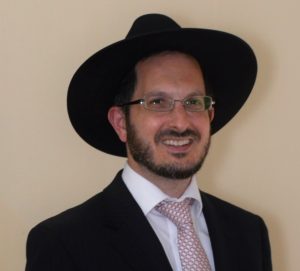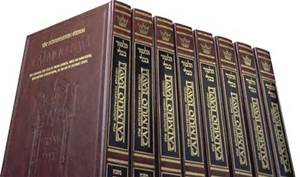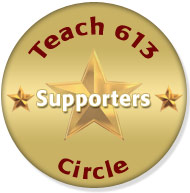Welcome to Take Ten for Talmud
Are you looking to study Daf Yomi, but are always on the go?
Can you dedicate just 10 minutes a day?
Try Take Ten for Talmud, and Learn the Highlights of the Daily Daf!
Listen from anywhere. Then blog your comments or questions.
Interact with Jews from all walks of life!
Join the online Beis Medrash of TEACH613, a place for…
Questions, Answers, and Real Learning!
What is Take Ten for Talmud?
Take Ten for Talmud by TEACH613™ offers a ten minute audio highlight of the Daf focusing on Talmud-study skill-building, as well as Hashkafa and Halacha L’Maaseh. Presented by Rabbi Mordechai Rhine, Rav of Southeast Hebrew Congregation in Silver Spring, Maryland, the Shiurim can be used to tag-along with Daf Yomi, or for Daf learners to review key points of the Daf.
We also invite you to post your own comments and chiddushim (2-5 sentences) relating to the shiurim, or to any other part of the Daf that you wish to ask or comment on.
For more information about TTfT please email RMRhine@teach613.org
This Week’s TTfT Topics Samples of TTfT by Topic

Rabbi Mordechai Rhine, Rosh Chabura
What is Talmud?
Talmud is a scholarly compendium of Jewish thought, tradition, and law, that is comprised of over 5,000 pages. The Talmud dates back to the year 550, where great academies debated and recorded the nuances of Judaism. What is noteworthy is that the Talmud is not neatly sectioned by topic. Instead a primary topic often gives way to secondary topics that are explored. In this way, the Talmud not only records facts and rulings, but possibly more importantly, it imparts to the student a way of thinking and a profound desire to discover accuracy and truth.
In addition to legal and philosophical issues, sometimes the Talmud will talk in a riddle or parable style to share a deep and profound message. Take for example the stories of Rabbah bar Bar Channah where he describes how he once traveled on a ship and encountered a fish that was so big that he thought it was land. “But when it got hot, the fish moved. If not for the fact that the ship was close by (and we were able to get back on the ship) we would have drowned.” By studying the commentaries that explain the symbolism of ships, boats, and “when it gets hot,” one can appreciate the deeper lesson of this Talmudic sage.
Sometimes Talmudic literature will explore questions that seem farfetched, such as “can a monkey effectuate kosher slaughter?” The student of the Talmud will wonder, “Did the Rabbis of the Talmud really think that a monkey could be trained as a shochet? How likely is it, that we must consider the possibility?” Yet the Talmud seeks to delve to the essence of every mitzvah, so that the eternal nature of Torah as G-d’s word can be explored. Indeed in our time, with robots, and computerized laser eyes, the question of a non-human doing shechita is a very practical one. By probing the very essence of life, sometimes with hypothetical cases, the Rabbis of the Talmud preserved a great deal of Jewish tradition in these volumes.
The student of Talmud will be challenged in a number of ways. Firstly, the text is Aramaic, without punctuation. Secondly, the style presupposes quite a bit of prior knowledge, as all Talmudic section are interrelated. But perhaps most importantly, the Talmud has a culture and style of its own. One who is not familiar with that culture and style can mistakenly quote phrases out of context, and misrepresent the message of this great literature.
Daf Hayomi
In 1923 Rabbi Meir Shapiro proposed the idea of a regimen of study in which participants would study one folio of Talmud each day. By doing so, one completes a cycle of studying the entire Talmud in 7 1/2 years. “What a great thing!” Rabbi Shapiro declared, “A Jew travels by boat and takes gemara Berachos under his arm. He travels for 15 days from Eretz Yisroel to America, and each day he learns the daf. When he arrives in America, he enters a beis medrash in New York and finds Jews learning the very same daf that he studied on that day, and he gladly joins them. Another Jew leaves the States and travels to Brazil or Japan, and he first goes to the beis medrash, where he finds everyone learning the same daf that he himself learned that day. Could there be greater unity of hearts than this?”
In the years following Rabbi Shapiro’s proposal on Daf Hayomi (one page a day), the idea has really taken hold in the Jewish world. It has become so popular that in certain ways in has taken a place in the Jewish world similar to Parsha, the weekly Torah portion. All kinds of support resources are available to assist people studying the daily Daf.
Highlights of the Talmud
However, there are many who find that studying the daily Daf in depth is a bit overwhelming. Perhaps you or someone you know doesn’t have a strong Judaic studies background. Perhaps you just doesn’t have the time to study the entire Daf, and would love a quick practical review of some of the key “Take-Home” Halacha, Hashkafa, or Talmud study-skill points that will assist you in future study. Take Ten for Talmud addresses these needs, and strives to keep the daily message at just about ten minutes.
You may notice from the recordings that the original participants grew enormously in their learning as they progressed in this course of study. Some of the later  recordings contain the basics of the Daf in the first ten minutes, and then proceed to go 2-3 minutes “overtime” with some fairly advanced insights. It is our hope that you will find that Take Ten for Talmud is an easy way to stay connected to the popular Daf Yomi program regardless of your personal background, study skills, or time constraints.
recordings contain the basics of the Daf in the first ten minutes, and then proceed to go 2-3 minutes “overtime” with some fairly advanced insights. It is our hope that you will find that Take Ten for Talmud is an easy way to stay connected to the popular Daf Yomi program regardless of your personal background, study skills, or time constraints.
Additionally, we are integrating these classes with the Encyclopedia section of the web site, so that you can research and study the topic that interests you. Please feel free to leave comments or questions on the Daf. Or, feel free to address questions or comments to us at RMRhine@teach613.org
Enjoy! And “Hatzlacha!” – Best wishes on your journey into Talmud study!
The Talmud is divided into Sedorim, or sections, each dealing with a primary topic.
* Seder Zeroim is on topic of agriculture and food. Its first mesechta is called Brachos which talks about blessings on food, as well as other blessings, such as those recited during prayer or on special occasions. Interestingly, it is the only mesechta in Seder Zeroim which has Babylonian Talmud. The other mesechtos primarily pertain to agriculture in the land of Israel, and are dealt with extensively in the Jerusalem Talmud.
* Seder Moeid is a grouping of mesechtos with focus on the Holy Days on a the Jewish calendar. It includes Shabbos, Succah, Rosh Hashana, and Megilah.
* Seder Nashim is focused on laws of marriage. It includes Kiddushin, Gittin, Kesubos, and Sotah.
* Seder Nezikin is focused on financial law. It includes mesechtos dealing with damages, real estate, and items entrusted from one person to his fellow.
* Seder Kodashim deals with laws of Korbanos, offerings in the Beis Hamikdash. Most notable is the mesechta called Chulin, meaning secular or mundane. This refers to the mesechta of Kosher slaughter and other topics of kashrus, which although very holy and sacred, are considered mundane when compared to the holiness of the Beis Hamikdash itself.
Chullin
Bechoros
Eirchin
Temurah
Kerisus
* Seder Taharos focuses on the laws of purity and impurity practiced mostly in the time of the Beis Hamikdash. The one mesechta in this section which does have Babylonian Talmud on it is the mesechta of Niddah, which not only deals with purity and impurity in the time of the Temple, but also pertains to the laws of intimate married life in our time.
Niddah



Rabbi, I enjoy your 12-15 min review immensely, I view it practically daily, Kol Hakavod for making Gemara so understandable. Thank you for making this great learning tool available!
Yasher Koach Rabbi on the completion of mesechatai Nedarim! The Gemara is NOT easy and frequently very complex. You make it so much easier to learn and enjoyable. I wish I could be learning with you in person. Thank you so much and Mazel Tov!! With much gratitude, Yuri
[…] Take Ten for Talmud by TEACH613 offers a ten minute audio highlight of the Daf focusing on Talmud-study skill-building, as well as Hashkafa and Halacha L’Maaseh. Presented by Rabbi Mordechai Rhine of the White Oak Shul in Silver Spring, Maryland, the Shiurim can be used to tag-along with Daf Yomi, or for Daf learners to review key points of the Daf. To subscribe please e-mail RMRhine@teach613.org.We also invite you to post your own comments and chiddushim (2-5 sentences) relating to the shiurim, or to any other part of the Daf that you wish to ask or comment on, at teach613.org/take-ten-for-talmud. […]
Amazing!! Short tidbits perfect for me to be able to keep my attention and focus on. Very well done. Keep up the great work!
[…] New for this cycle is a program called "Take Ten for Talmud" by TEACH613™, which enables everyone to engage the daily Daf on their own level. An audio class of approximately ten minutes is posted for beginners and for those who want to review the highlights of the Daf, while the blogging feature invites participants on all levels to post insights, questions, and responses. I have the honor of serving as the moderator for the project, and invite you to sign up to participate at http://www.teach613.org/take-ten-for-talmud/. […]